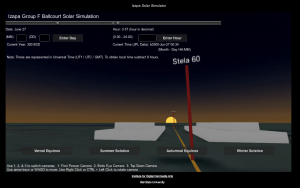Mayan Solar Simulator
Izapa Group F Ballcourt
We have applied our Virtual Solar Simulator to a simple white model build of the pre-Columbian ballcourt in Group F at the Izapa site in Chiapas, Mexico. Izapa is considered to be the birthplace of the Mayan Long Count, which ends its cycle today on December 21st, 2012 – the winter solstice. Viewed today, the site is oriented on an axis where it is aligned generally but not precisely to sunrise on the winter solstice and to sunset on summer solstice. In direct observation today, the alignment along the axis of the ballcourt from the throne #2 to the stela #60 is off-axis by approximately two degrees.
The simulator can be visited here:
https://projects.idialab.org/izapasolarsimulator.html
* The simulation requires Internet Explorer and the Unity plugin.
The solar simulator developed by IDIA Lab at Ball State University polls data from the NASA / JPL Horizons database (http://ssd.jpl.nasa.gov/horizons.cgi) calculates celestial objects position (sun, moon, planets, comets, etc). The database takes into account for the Chandler Wobble – a periodic deviation in the rotation of the Earth’s axis. Archeo-astronomical alignments that are viewed today at Izapa appear to be off-axis, however when compensated for changes in time, rotation, position and Chandler effect via this simulation method, the solstice events come back into their original orientation for the era of their construction and can be observed to be in actual alignment.
A b’ak’tun is 144,000 days in length – almost 400 years. In the Mayan Long Count it took 13 b’ak’tuns to progress throughout a full cycle of creation. Dec. 21, 2012, marks the end of the 13th b’ak’tun of this Mayan calendar and after today’s solstice, the next Long Count cycle begins again – another 5128.8 years.
Happy New Mayan Long Count!
– John
December 21st, 2012
Simulator:
https://projects.idialab.org/izapasolarsimulator.html
* The simulation requires Internet Explorer and the Unity plugin.
It requires the Unity plugin http://unity3d.com/webplayer/
Note on display time and date
Dates are in the year 300 BCE/BC.
Time is represented in Universal Time (UT1/UTC/GMT).
To obtain local time for the Izapa site, subtract 6 hours from the UT time displayed in the simulator.
Next release will provide solstice and equinox preset for the year 2012 for comparison.
Camera control
To switch cameras press the 1 for 1st person camera view, 2 is for bird’s eye view and 3 is for top down view.
To pan use the WASD keys and to zoom use the middle mouse button. To rotate camera use CTRL-Click or Right Mouse Button.
Background
The model is geolocated and accurately referenced in 3D space by latitude, longitude, orientation and elevation. The Horizons database is then scraped using these coordinates as well as the year of interest – in this case we chose 300 BCE/BC as an apogee in the range in which the Izapa site was inhabited.
IDIA Lab has developed the celestial simulation – which can also track the moon and planets, etc – to work on various Cultural Heritage and archeo-astronomy projects in collaboration with international scholars. Other projects utilizing the Celestial Simulator include simulations of Hadrian’s Villa, the Roman Pantheon, the Solarium Augusti in Rome (the largest sun calendar of the ancient world), the Temple of Artemis in modern Turkey (one of the ancient wonders) and Stonehenge.

